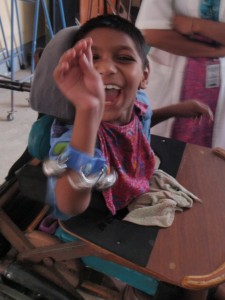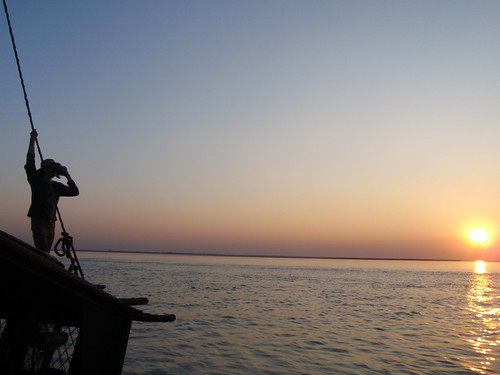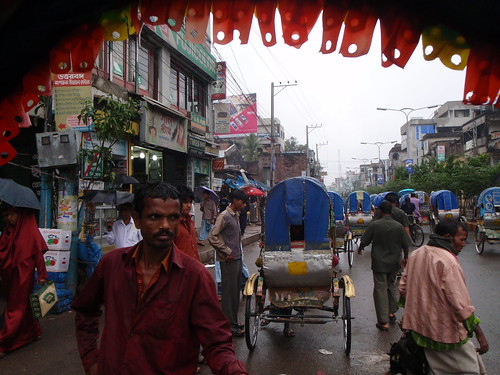As expected the weeks are flying by. I should mention that my internship is now officially a WHO internship, and while I continue to work with ICDDR,B on the module of occupational injury questions for integration into their Health and Demographic Surveillance System, I have also been meeting and making contacts with other organizations relevant to occupational health and safety. In this posting I describe four of them.
Centre for Rehabilitation of the Paralyzed (CRP)
40 years ago while still East Pakistan, Valerie Taylor, an English physiotherapist, left to work at a leprosy hospital in the Chittagong Hill tracts with Voluntary Service Overseas (VSO). 10 years later, in 1979, she acted on the need she saw for assistance to the disabled, especially the paralyzed, by founding the Centre for Rehabilitation of the Paralyzed (CRP).

Today, the organization is one of the most well recognized and respected in Bangladesh, and has expanded to include over 100 beds, including some designed specially for the paralyzed (with mirrors and harnesses). It has a pediatric unit to train mothers to care for their children with cerebral palsy, with up to an eight month waiting list, and a school for children with cerebral palsy (often orphans) who are eventually integrated into regular schools. It offers physiotherapy and occupational therapy services to thousands of out-patients each year, and the newest addition is a department for speech therapy, including training of Bangladeshi speech therapists.
350 paraplegic and quadriplegic patients are admitted annually, some children, and often as a result of carrying heavy loads on their heads (sandbags, bricks, etc). Amazingly, all wheelchairs are made in a metal work shop on-site, specific to each patient, with rickshaw parts! Numerous ramps with various terrains have been constructed for the patients to practice so they can use the wheelchairs back in their villages. In fact, a halfway-house has been created with and without electricity, depending on the condition of the patients’ home village, for them to get used to before going home.
All prosthetics are made on site using casts and an oven to shape the plastic. There is also an independent living centre for disabled women, and a vocational training (sewing, electronic repairs, etc) centre so patients can learn income generating skills that can be performed while in their physical condition.
CRP attracts interns, professionals, and donors from all over the world. Valerie has been awarded the Order of the British Empire, the “Shadhinota Dibosh Podok”, Bangladesh’s highest civilian honour, and in 1998 she was made an honourary Bangladeshi citizen.
Centre for Corporate Accountability (CCA)
The Centre for Corporate Accountability (CCA) is a charity, promoting worker and public safety in Bangladesh. It was initially an organization in the UK, but executive director, David Bergman, set up the office in Dhaka in 2004. Its focus is on “the role of state bodies in enforcing health and safety law, investigating work-related deaths and injuries, and subjecting them to proper and appropriate prosecution scrutiny”.
Last year, working with Bangladesh Occupational Safety, Health and Environment Foundation (OSHE) and the Bangladesh Institute of Labour Studies (BILS), CCA published a report compiling worker deaths reported in the national Bengali and English newspapers in 2007. Results showed the majority of worker deaths were occurring in the construction sector, a contradiction from ILO estimates that state they are agricultural.
While I met David at a meeting arranged with WHO and OSHE (described in the next section), Valerie from CRP had also suggested I meet him; apparently CCA is investigating some work-related injuries from CRP, which could possibly lead to real compensated claims, a rarity in Bangladesh.
Bangladesh Occupational Safety, Health, and Environment Foundation (OSHE)
The Bangladesh Occupational Safety, Health, and Environment Foundation (OSHE) was established in 2003 to address issues affecting worker health and safety, income, employment, and overall livelihood. OSHE is a national collaborating center of the International Labour Organization.
My first encounter with OSHE was last year when Dr. Hugh Davies and I visited representatives in Chittagong, at one of the satellite clinics they had set up specifically for shipbreakers. I met with representatives again this visit at a meeting with WHO and CCA; this was a meeting to discuss their plans for future work resulting from the evidence of high fatalities in the construction industry from the CCA report on workplace fatalities.
Centre for Injury Prevention and Research, Bangladesh (CIPRB)
Finally, I went to visit a contact from my trip last year who is feeling more like an old friend now: Dr. Bennoor, a physician and assistant professor of respiratory medicine at the “National Institute of Diseases of the Chest and Hospital”, in Dhaka. While telling him about my current project on occupational injury surveillance, he suggested another person I should meet. Dr. Fazlur Rahman is the executive director of the Centre for Injury Prevention and Research, Bangladesh (CIPRB), and Dr. Bennoor arranged for me to meet him later that afternoon.
Dr. Rahman initiated this centre for injury research four years ago and they focus on preventing injuries in children, including child labourers. CIPRB has a very impressive surveillance system; they gather health and demographic information from 800,000 people: 200,000 in four areas (three rural, one urban; different from the ones I will be working with at ICDDR,B). 60 people are employed to gather information 4 times a year. They are finding that the major injury causing death in children is drowning, and have implemented swimming lesson programs for children aged 4-10 across the country.


